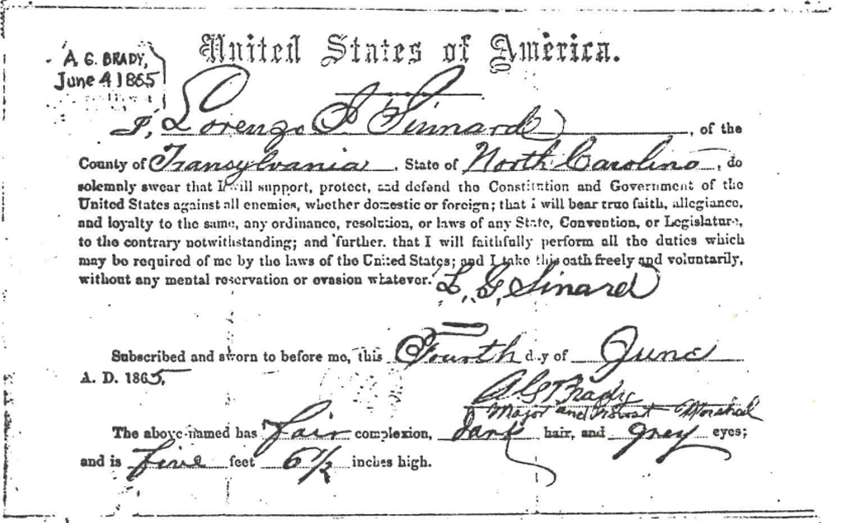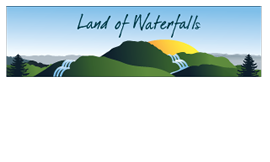
When Transylvania County was founded in 1861, many of the earliest organizers had Brevard streets named for them in honor of their contributions to the community. The next founder to be highlighted in this series is Lorenzo Gaston Siniard (1838-1907), namesake of Gaston Street which runs roughly parallel to Broad Street, terminating at East Main Street and Varsity Street at either end.
Lorenzo Gaston Siniard was the son of Captain James Lamb Siniard Jr. (1808-1877) and Eleanor Lee Glazener (1816-1893) both of Buncombe County, and the second of ten siblings. Siniard married Margaret Mahalia Wilson (1839-1912) in Henderson County on March 7, 1859. Their only child Columbus Millard Siniard was born later that year. They eventually became Transylvania County residents due to shifting county boundaries.
An anecdotal story in the Asheville Daily Gazette tells of Siniard’s encounter with a panther and what he did to tree it and escape. If this is indeed a true story, it demonstrates that he was quick-thinking, non-confrontational, and adaptable in the face of danger.
Siniard and his family were active in the local Methodist congregation. Methodists were holding services in the area long before Transylvania County’s founding when the gatherings began in family homes, or “meeting houses”. In the 1840s the local Methodists established a campground for revival services each year. In 1847 Siniard’s future father-in-law Samuel Wilson, who owned the Methodist campground land, offered a running lease for the campground on property that is today at the foot of the Deer Lake neighborhood. As many as 27 family tents were used for as long as two weeks at a time until the Civil War.
During the Civil War bushwhackers, or rogue combatants who target civilians, had gotten so out of control in the area that state militia were called in to protect those civilians. Common tactics used by bushwhackers included ambushing individuals and families or raiding farms to steal supplies, food, and anything else of value. State troops camped in one of the only available places large enough to accommodate them – the Methodist campground. In an effort to drive the opposition away bushwhackers set fire to the campground, leading to its decimation. Out of this crisis came the decision to build the first Methodist church in the area: Oak Grove Methodist Episcopal Church South.
The church was meant to be built on a two-acre plot of land donated by Alexander Allison. Once the church was complete, it was discovered that it was on an incorrect parcel of land that instead belonged to L. G. Siniard. Siniard and Allison swapped equitable land to right the mistake; however, in an act of generosity Siniard then donated the exchanged parcel to the church for use as a burial ground.

When the Civil War began in 1861, Lorenzo enlisted in the Confederate Army. As a result of his service, he was taken as a prisoner of war in 1865 when General Lee surrendered at Appomattox. His sworn statement of allegiance to the United States was required for his release.
Siniard bought the land that would become the Oak Grove Methodist Campground in 1868. Lorenzo, and later his son Columbus, developed the over 300-acre plot into the campground site that eventually became Camp Carolina for a time and later Deerlake Village. The old Siniard place was located northeast of the intersection of Deerlake Road and Deer Run on a small hill.
Following the Civil War, the Methodist Church grew to the point that a second congregation was needed in town. In the 1870s, the Gaston Street Methodist Church was created, which later became Brevard First United Methodist Church.
Lorenzo Gaston Siniard lived out his life in Transylvania County. Although his death date has been recorded as December 23, 1906, further research has uncovered that it was actually one year later on December 24, 1907. The January 10, 1908 Brevard News published a memoriam stating that he had been suffering from increasing paralysis over some time before eventually succumbing to his health concerns on Christmas Eve of 1907. His memory lives on in the name of Gaston Street, his middle name.
Photographs and information for this column are provided by the Rowell Bosse North Carolina Room, Transylvania County Library. This article was written by Local History Librarian Laura Sperry. Sources available upon request. For more information, comments, or suggestions, contact NC Room staff at [email protected] or 828-884-1820.



